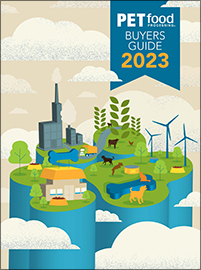WIESBADEN, GERMANY — The Industry Association for Pet Supplies (IVH) and the Central Association of Zoological Specialists in Germany (ZZF) recently released new data detailing pet trends throughout Germany. The data detailed the growth of the pet care and pet food markets and shifting pet populations throughout 2022.
The survey analyzed responses from 5,000 German households.
Felines remain king
According to the data, there are 34.4 million pets, excluding fish and reptiles, throughout German households with 46% of all households owning at least one pet. Additionally, 14% of all households throughout the country own at least two different types of pets, whether that’s a combination of dog andcats, rabbits and birds, etc.
The data also shows that larger households are more likely to have a pet, as 36% of households with at least three people reported owning a pet whereas only 29% of one-person households owned a pet. Within multi-person households, IVH and ZZF found that more than half (67%) of all German families with children own a pet.
“In an increasingly digitized and restless world, pets are an important anchor and haven of peace for many people — this is especially true for children, whose development can be promoted in many ways by animals,” said Georg Müller, chairman of the IVH.
Cats make up a majority of the German pet population at 15.2 million, with 24% of German households owning at least one cat. Twenty-one percent of households own at least one dog, amassing to 10.6 million dogs throughout the country. Three percent own a pet bird, amassing to a population of 3.7 million; 4% own some type of aquaria pet, amassing to a population of 2.3 million; 3% own some type of ornamental fish, amassing to a population of 1.4 million; and 2% own a type of terraria pet (like a turtle), amassing to a population of 1.3 million. Five percent own another type of small pet, amassing to a population of 4.9 million.
“The total number of pets kept in households in Germany has remained largely stable at a high level over the past few years,” said Norbert Holthenrich, president of the ZZF. “We are extremely pleased about that. Keeping pets can greatly enrich people's lives. It is important that the focus is always on the welfare of the animals and their needs.”
Nutrition sales growth
With a large pet population, IVH and ZZF shared significant growth for the German pet nutrition industry. According to the data, prepared pet food sales in the brick-and-mortar channel hit €4.03 billion ($4.44 billion USD), a 9.5% increase from 2021.
Note: Currency conversions are based on May 5 conversion rates.
Pet food sales consisted of 78% of all brick-and-mortar pet care sales, which topped €5.13 billion ($5.66 billion USD) in 2022, an increase of 7.1% compared to 2021.
“In the pet food sector, sales increased for the most part,” Müller said. “This is mainly due to the current inflation. Like manufacturers of other everyday products, producers of ready-to-eat pet food have also had to raise their prices in view of the sometimes immense cost increases in energy, packaging and logistics.”
Unsurprisingly, cat food witnessed the highest brick-and-mortar sales growth at a 12.5% increase from 2021, topping €2.01 billion ($2.22 billion USD) in 2022. Wet cat diets held the highest number of sales at €1.33 billion ($1.47 billion USD), a 13.6% increase from 2021. Dry cat food sales increased 9.4% to €356 million ($392 million USD); and snacks/cat milk increased the most at 11.8%, amassing €326 million ($359 million USD) in sales.
Dog food witnessed brick-and-mortar sales growth of 7.8% in 2022, achieving €1.81 billion (nearly $2 billion USD). Dog snacks are king in this particular category with 2022 sales of €696 million ($767 million USD), though this category experience the least amount of growth, increasing 3.6% from 2021. Wet dog food experienced the highest growth, increasing 13.4% to €595 million ($656 million USD) in sales. Dry dog food increased 7.4%, amassing €516 million ($568 million USD) in brick-and-mortar sales in 2022.
Within the brick-and-mortar channel, IVH and ZZF detailed two specific channels from which a bulk of pet food sales are coming — food retail, which includes drugstores, and specialized trade retailers, which include pet, agricultural and garden center shops.
More than half (62%) of pet foods were purchased at food retail locations, amassing to €2.5 billion ($2.76 billion USD). Just 38% of pet food products were purchased at specialized trade retail locations, amassing €1.52 billion ($1.68 billion USD) in sales.
“In retail, pet owners regularly asked about pet food and other everyday items, such as cat litter,” Holthenrich said. “In the case of necessities and accessories such as dog beds or scratching posts, however, purchases were postponed in 2022. The effects of the tense financial situation of many consumers were increasingly felt here.”
On the e-commerce side, pet care sales for 2022 totaled €1.2 billion ($1.32 billion USD), a whopping 14% increase from the prior year. Despite this significant increase, IVH and ZZF shared that “no differentiated, species-specific data on the online market is available.”
Read more about pet retail trends.




